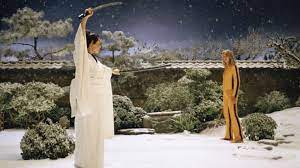Kill Bill: Vol. 1 (2003)

🎬🎬 Kill Bill: Vol. 1 | 2003 | Starring: Uma Thurman, Lucy Liu, Vivica A. Fox
Synopsis:
Kill Bill: Vol. 1, directed by Quentin Tarantino, is a gritty, stylized revenge saga that follows The Bride (Uma Thurman), a former assassin who awakens from a four-year coma after being betrayed and left for dead by her ex-boss Bill and his Deadly Viper Assassination Squad. Driven by vengeance, she embarks on a bloody quest to hunt down and eliminate the members of the squad, starting with Vernita Green (Vivica A. Fox) and O-Ren Ishii (Lucy Liu).
The film weaves together multiple cinematic influences, from martial arts epics to spaghetti westerns, creating a vibrant tapestry of action, violence, and dark humor. Packed with iconic set pieces, such as the explosive showdown with the Crazy 88 gang, Kill Bill: Vol. 1 is an unforgettable journey through the stylistic extremes of Tarantino’s filmmaking.
Review:
Kill Bill: Vol. 1 is Quentin Tarantino at his most audacious and visually inventive, delivering a visceral, blood-soaked ode to the genres that have inspired him. From its meticulously choreographed fight scenes to its emotionally charged moments of introspection, the film is a masterclass in blending style and substance.
The opening scene immediately sets the tone. The stark black-and-white imagery of The Bride lying bloodied on the floor, followed by Bill’s chilling voice and the sound of a gunshot, plunges the audience into the heart of the story. Tarantino’s nonlinear storytelling shines here, teasing the audience with fragments of The Bride’s tragic past while keeping her motivations crystal clear.
Uma Thurman’s portrayal of The Bride is nothing short of iconic. Her performance balances raw physicality with emotional depth, making her both a fierce warrior and a deeply sympathetic figure. Thurman’s intensity in the fight scenes is matched only by her moments of vulnerability, particularly in the flashbacks to her betrayal.
Lucy Liu’s O-Ren Ishii is a standout among the Deadly Viper Assassination Squad. Liu brings elegance and menace to the role, making O-Ren a formidable adversary for The Bride. Her backstory, depicted through an anime-inspired sequence, is a bold and striking choice that adds layers to her character while paying homage to Japanese storytelling traditions.
The film’s action sequences are its crowning glory. The fight between The Bride and Vernita Green in a suburban home is brutal and grounded, contrasting sharply with the hyper-stylized carnage of the climactic showdown at the House of Blue Leaves. The latter, featuring The Bride’s battle against the Crazy 88 gang and her duel with O-Ren, is a dazzling spectacle of choreography, cinematography, and Tarantino’s trademark flair for excess. The use of silence, shifts in color palettes, and splashes of over-the-top gore elevate the sequence into an unforgettable cinematic moment.
Tarantino’s love for genre cinema is evident in every frame. The film is a melting pot of influences, from samurai films like Lady Snowblood to spaghetti westerns and grindhouse cinema. These references never feel derivative; instead, they are woven into the fabric of the story, creating a fresh and exhilarating experience.
The soundtrack is another standout element, curated with Tarantino’s impeccable taste. Tracks like Nancy Sinatra’s “Bang Bang (My Baby Shot Me Down)” and RZA’s contributions perfectly complement the film’s tone, amplifying its emotional and stylistic beats. The use of music in the House of Blue Leaves sequence, particularly the hauntingly energetic “Don’t Let Me Be Misunderstood” by Santa Esmeralda, is masterful.
Visually, Kill Bill: Vol. 1 is a feast for the eyes. Cinematographer Robert Richardson crafts a dynamic and kinetic aesthetic, using bold colors, dramatic lighting, and inventive camera angles to enhance the film’s energy. The transitions between black-and-white, vivid color, and silhouette further demonstrate Tarantino’s willingness to experiment and push boundaries.
Despite its many strengths, the film’s relentless focus on style may alienate some viewers. Its extreme violence, while intentionally exaggerated, can feel excessive, and the lack of resolution (given the two-volume structure) might leave some yearning for a more complete narrative. However, these aspects are largely intentional, serving Tarantino’s vision of a revenge saga split into two distinct parts.
Kill Bill: Vol. 1 is ultimately a celebration of cinema’s visceral power and storytelling potential. It’s a film that revels in its contradictions: brutal yet beautiful, chaotic yet meticulously crafted. Tarantino’s ability to balance homage with innovation ensures that the film feels timeless, appealing to both cinephiles and casual audiences.
The cliffhanger ending, with The Bride learning a critical piece of information about her presumed-dead daughter, sets up Vol. 2 perfectly, leaving viewers desperate for the conclusion of her journey.
Box Office Earnings:
Kill Bill: Vol. 1 was a commercial success, grossing $180 million worldwide against a $30 million budget. Its bold style, memorable performances, and innovative storytelling cemented its place as a modern classic and one of Tarantino’s most celebrated works.